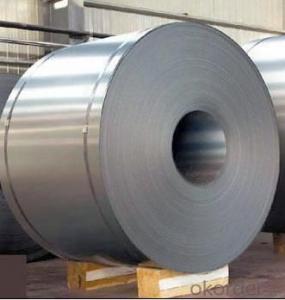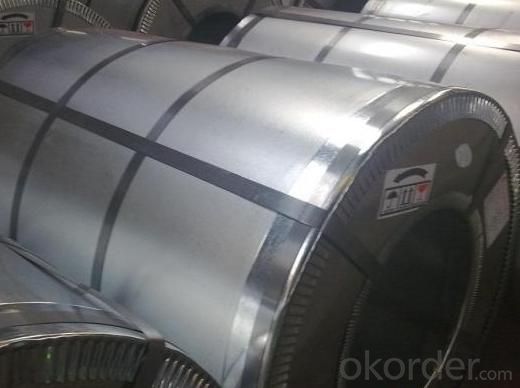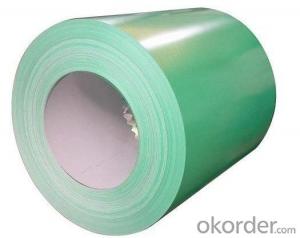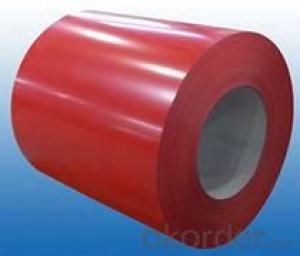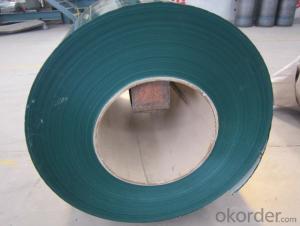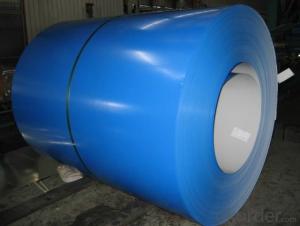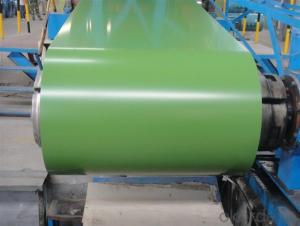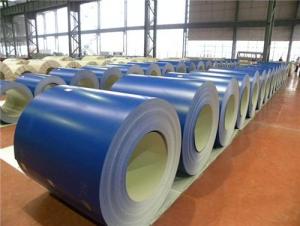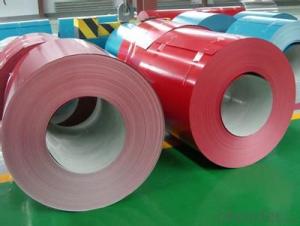Prepainted Galvanized Steel Coils/Rolled Steel Coil Plate
- Loading Port:
- Shanghai
- Payment Terms:
- TT OR LC
- Min Order Qty:
- 50 m.t.
- Supply Capability:
- 10000 m.t./month
OKorder Service Pledge
OKorder Financial Service
You Might Also Like
Basic Info.
Model NO.:CGCC, JIS3312
Surface Treatment:Coated
Certification:ISO, SGS
Technique:Cold Rolled
Standard:ASTM, JIS, GB
Application:Construction, Roofing and So on
Edge:Slit edge
Stock:Stock
Steel Grade:Q195-235
Thickness:0.16-0.8mm
Width:800-1250mm
Color:Ral Number
Zinc:30G/M2-100G/M2
Coils Weight:3-5tons/Coils
Export Markets:Global
Additional Info.
Packing:Export Standard Packing
Standard:JIS G3312
Origin:China
HS Code:72107000
Production Capacity:100000tons/Year
Product Description
Prepainted galvanized steel coils
1. PPGI, prepainted galvanized steel coil(Annual Output: 200, 000tons)
(1). Leading manufacturer in China
(2). Competitive price
(3). High quality
(4). Good after-sale service
2. The Feature of PPGI:
1). Geade: CGCC, other grade can be available
2). The thickness range of the PPGI: 0.16mm to 0.8mm
Tolerance of thickness of The PPGI: +/-0.03mm
3). Width range: 800mm to 1250mm
Tolerance of width: +/-3.00mm (aiming to +/-2.00mm)
4). Zinc coating: Z40-Z275
5). Coil internal diameter: 508mm
6). Packing: Standard waterproof paper and galvanized steel protection cover and steel strip packed
7). Applications of PPGI: Widely used for roofs, outer walls, ovens, Explosive-proof steel, electrically controlled cabinets, and industrial freezers in the Residential and industrial buildings
- Q: What is the maximum width of a steel coil?
- The maximum width of a steel coil can vary depending on factors such as manufacturing capabilities and customer requirements. However, in general, steel coils can have a maximum width ranging from 30 inches to 96 inches or even wider.
- Q: Does steel contain nickel?
- Yes. Different alloys contain differing amounts.
- Q: Many gerber knives are made out of what gerber calls high Carbon steels and I was wondering if anyone knew exactly what is this mysterious steel.
- Carbon, when added to steel increases the hardness of the metal. The higher the carbon content the harder(pure carbon = diamond) the blade will be and the longer it will hold its sharpened edge. Too much carbon however can make it too brittle to use as a blade. iron, carbon and chromium(for the stainless in stainless steel) mixed in the right portion makes a high carbon stainless steel knife. All of which is kinda pointless if the blade is not forged correctly.
- Q: What are the different coil packaging methods used for steel coils?
- Steel coils can be packaged using various methods to guarantee their protection and secure transportation. These methods also help optimize storage space. Some of the commonly used packaging methods for steel coils are as follows: 1. Strapping: Metal or plastic straps are used to secure the steel coils. This ensures stability and prevents unrolling or shifting during transportation. Strapping is suitable for smaller coils or when other packaging methods are also utilized. 2. Stretch wrapping: Steel coils are tightly wrapped using a stretch film. This technique provides excellent protection against dust, moisture, and other contaminants. It also keeps the coils tightly bound and prevents movement during handling and transportation. 3. Steel banding: Steel bands or straps are employed to secure the coils. This packaging method offers superior strength and durability. It is ideal for larger and heavier steel coils that require additional reinforcement. 4. Wooden crating: Particularly large or heavy steel coils are packaged in wooden crates. These crates provide enhanced protection against impacts, moisture, and other external factors. Wooden crating is commonly used for long-distance transportation or when coils need to be stored for extended periods. 5. Coil saddles: Specialized devices called coil saddles are used to package large coils securely. These devices prevent rolling or movement. Coil saddles are preferred when strapping or wrapping is not feasible. 6. Paper interleaving: Sheets of paper are placed between each layer of steel coils to prevent damage caused by friction. This method is commonly used for coils with a high surface finish or those susceptible to scratching. Each of these packaging methods offers distinct advantages and is chosen based on factors such as coil size, weight, transportation requirements, and desired level of protection. By employing these methods, steel coil manufacturers and distributors can ensure the safe arrival of their products in optimal condition.
- Q: many sword sellers sell swords made of 440 and stainless, i know those are both totally **** for real swords. so are 1045, 1060, or 1095 good grades of steel for a sword?
- Carbon Steel is the most common, while most live-steel(designed for use) ready sword utilize on of the spring steels you mentioned. Hybrid steel like those used in the Slayer series seem neigh-indestructible. The steel should be strong enough to not notch on a strike, but flexible enough to flex when you bend it, lest it shatter on a hard blow.
- Q: Can steel coils be cut or trimmed after delivery?
- Yes, steel coils can be cut or trimmed after delivery. Steel coils are typically delivered in large sizes and can be easily cut or trimmed to the desired length or shape using various cutting methods such as shearing, slitting, or laser cutting.
- Q: What are the different types of steel coil cutting tools?
- In the market, one can find a variety of steel coil cutting tools. These tools have been specifically designed to efficiently and accurately cut steel coils. Some of the commonly used types of steel coil cutting tools include: 1. Slitting shears: These shears are widely utilized to cut steel coils into narrow strips. Equipped with multiple blades, slitting shears offer clean and precise cuts without causing any damage to the material. They are typically employed in high-volume production and are capable of handling different thicknesses of steel coils. 2. Rotary shears: Another commonly used cutting tool for steel coils is the rotary shear. These shears consist of rotating blades that shear through the material as it passes through them. Rotary shears are perfect for cutting medium to thick steel coils and are known for their high cutting speed and accuracy. 3. Guillotine shears: Guillotine shears are heavy-duty cutting tools that can handle thick steel coils. They operate by exerting a downward force to cut through the material in one clean stroke. Renowned for their power and precision, guillotine shears are suitable for cutting large volumes of steel coils. 4. Laser cutting machines: Advanced cutting tools like laser cutting machines employ a high-powered laser beam to cut through steel coils. These machines offer precise and intricate cuts with minimal heat distortion. Laser cutting machines are ideal for cutting complex shapes and patterns on steel coils. 5. Water jet cutting machines: Water jet cutting machines utilize a high-pressure stream of water mixed with abrasive particles to cut through steel coils. This method provides high accuracy and does not generate heat, making it suitable for cutting heat-sensitive materials. Water jet cutting machines can cut through various thicknesses of steel coils and produce smooth edges. Each type of steel coil cutting tool has its own advantages and is suitable for different applications. The choice of tool depends on factors such as the thickness of the steel coil, required precision, production volume, and budget.
- Q: How are steel coils coated for color and aesthetics?
- Steel coils can be coated for color and aesthetics through a process called coil coating. This process involves applying a layer of paint or coating material to the surface of the steel coil to enhance its appearance and provide protection against corrosion. The coil coating process typically begins with a thorough cleaning and pre-treatment of the steel surface. This step ensures that the surface is free from any contaminants and provides a suitable base for the coating to adhere to. The pre-treatment process may involve cleaning, degreasing, and chemical treatment to enhance the adhesion and durability of the coating. Once the surface is prepped, the coil is then fed through a continuous coating line. In this line, the coating material, which is usually a liquid paint, is applied to both sides of the steel coil using various methods such as roll coating, spray coating, or electrostatic coating. The coating material is carefully selected to provide the desired color, texture, and durability. After the coating is applied, the coil goes through a curing process, where it is heated to allow the coating material to dry and bond to the steel surface. This ensures a strong and durable finish that can withstand exposure to various environmental conditions. Coil coating technology also allows for additional treatments to enhance the aesthetics of the steel coil. For example, the coil can undergo a process called embossing, where a pattern is embossed onto the surface, giving it a textured or three-dimensional appearance. Additionally, other decorative techniques like printing, laminating, or adding metallic effects can be employed to achieve specific aesthetic effects. Overall, the coil coating process not only adds color and aesthetics to steel coils but also provides a protective layer that increases their lifespan and resistance to corrosion. This makes them suitable for a wide range of applications, including roofing, automotive parts, appliances, and construction materials.
- Q: what do they use to make stainless steel?and can stainless steel be melted again and again without losing it's Specifications
- The stainless steel is a family of ferrous alloys containing at least 11% chromium. The effect of this amount of chromium in steel in reducing corrosion is dramatic. There are many grades of stainless steels. By varying the chemical composition, heat treating, and cold-working, a wide range of properties is achieved. There are three types of precipitation hardening stainless steels: *martensitic types, which are supplies in the martensitic condition, are hardened by a simple aging treatment of the fabricated part. *Semi austenitic types, which are supplied in the austenitic condition, are transformed to martensite by special heat treatment before precipitation hardening. *the austenite in the austenitic types is precipitation hardened directly. The heat treatments of precipitation-hardening stainless steels are chosen to optimize mechanical properties. Precipitation hardening generally results in a slight increase in corrosion susceptibility and an increased susceptibility to hydrogen embrittlement.
- Q: What are the different types of steel coil grades?
- There are several different types of steel coil grades, including hot rolled coil (HRC), cold rolled coil (CRC), galvanized coil (GI), galvannealed coil (GA), and stainless steel coil.
Send your message to us
Prepainted Galvanized Steel Coils/Rolled Steel Coil Plate
- Loading Port:
- Shanghai
- Payment Terms:
- TT OR LC
- Min Order Qty:
- 50 m.t.
- Supply Capability:
- 10000 m.t./month
OKorder Service Pledge
OKorder Financial Service
Similar products
Hot products
Hot Searches
Related keywords
